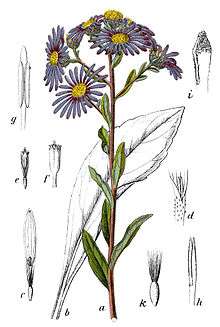Asteroideae
Asteroideae is a subfamily of the plant family Asteraceae. It contains about 70% of the species of the family.[1] It is made of several tribes, including Astereae, Calenduleae, Eupatorieae, Gnaphalieae, Heliantheae, Senecioneae and Tageteae. Asteroideae contains plants found all over the world, many of which are shrubby. There are about 1,135 genera and 17,200 species within this subfamily; the largest genera by number of species are Helichrysum (500-600) and Artemisia (550). Asteroideae is said to have begun approximately 46-36.5 million years ago.[2]
| Asteroideae | |
|---|---|
 | |
| Illustration of Aster amellus from tribe Astereae | |
| Scientific classification | |
| Kingdom: | Plantae |
| Clade: | Tracheophytes |
| Clade: | Angiosperms |
| Clade: | Eudicots |
| Clade: | Asterids |
| Order: | Asterales |
| Family: | Asteraceae |
| Subfamily: | Asteroideae Lindl. |
| Tribes | |
| |
Tribes
This subfamily is composed of 21 tribes that are broken into 3 supertribes: Senecionodae, Asterodae, and Helianthodae. Senecioneae contains about 120 genera and more than 3200 species that are found in more temperate areas.[3] Asterodae contains many economically important plants such as the chrysanthemums, common daisy, and the asters. The third super tribe is the Helianthodae, which is the largest of the three, containing 16 of the 21 tribes.[4]
Common characteristics
This family will often have radiate style heads but some could have discoid or disciform. They contain ray florets that are three lobed and are also considered perfect flower implying that it is bisexual. Many contain stigmatic surfaces that are separated by two marginal bands and terminal sterile appendages with sweeping hairs.[5]
Uses
The subfamily Asteroideae has many genera within the tribes that have economic uses. The Helianthus tuberosus (Jerusalem artichoke), Helianthus annuus (sunflower), Guizotia abyssinica (niger seed) are all used as oil seed crops. Artemisia dracunculus (tarragon) is used for culinary herb and Parthenium argentatum (guayule) is a rubber source. Some of the other genera are used as ornamentals; those are Dendranthema spp. (chrysanthemum), Callistephus, Cosmos, Tagetes (marigold), and many others.[6]
Classification
Since 2004, the 21 tribes have been grouped into three supertribes:[1]
- Senecionodae
- Senecioneae (Doronicum is sometimes placed in a separate tribe Doroniceae[7])
- Asterodae
- Anthemideae (including chrysanthemums)
- Astereae (including asters and the common daisy)
- Calenduleae (including calendulas)
- Gnaphalieae
- Helianthodae
- Athroismeae
- Bahieae
- Chaenactideae
- Coreopsideae (including cosmos and dahlias)
- Eupatorieae
- Feddeeae
- Helenieae (including gaillardias)
- Heliantheae (including sunflowers and zinnias)
- Inuleae
- Madieae
- Millerieae
- Neurolaeneae
- Perityleae
- Plucheeae[8]
- Polymnieae
- Tageteae (including marigolds)
References
- Asteraceae, Tree of Life Web Project
- Huang, C. -H; Zhang, C; Liu, M; Hu, Y; Gao, T; Qi, J; Ma, H (2016). "Multiple polyploidization events across Asteraceae with two nested events in the early history revealed by nuclear phylogenomics". Mol. Biol. Evol. 33 (11): 2820–2835. doi:10.1093/molbev/msw157. PMC 5062320. PMID 27604225.
- Barkley, Theodore M.; Brouillet, Luc; Strother, John L. "Asteraceae tribe Senecioneae". In Flora of North America Editorial Committee (ed.). Flora of North America North of Mexico (FNA). 19, 20, and 21. New York and Oxford – via eFloras.org, Missouri Botanical Garden, St. Louis, MO & Harvard University Herbaria, Cambridge, MA.
- Panero, J.L; Crozier, B.S. "Asteraceae: Sunflowers, daisies". Tree of Life. Retrieved 2019-04-06.
- Lindley, J. "The Vegetable Kingdom". Cite journal requires
|journal=(help) - Murrell, Z.E (2010). Vascular Plant Taxonomy. Kendall Hunt Publishing Compant.
- Fernandez, I (2001), "A Phylogenetic Analysis of Doronicum (Asteraceae, Senecioneae) Based on Morphological, Nuclear Ribosomal (ITS), and Chloroplast (trnL-F) Evidence", Molecular Phylogenetics and Evolution, 20 (1): 41–64, CiteSeerX 10.1.1.331.4339, doi:10.1006/mpev.2001.0954, PMID 11421647
- Anderberg, A (2005), "Evolutionary relationships in the Asteraceae tribe Inuleae (incl. Plucheeae) evidenced by DNA sequences of F; with notes on the systematic positions of some aberrant genera", Organisms Diversity & Evolution, 5 (2): 135–146, doi:10.1016/j.ode.2004.10.015
External links


